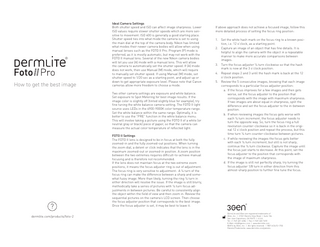Guide
1 Page

Preview
Page 1
®
How to get the best image
Ideal Camera Settings Both shutter speed and ISO can affect image sharpness. Lower ISO values require slower shutter speeds which are more sensitive to movement. ISO 400 is generally a good starting place. Shutter speed ties into what mode the camera is set to using the main dial at the top of the camera body. Nikon has limited what modes their newer camera bodies will allow when using manual lenses such as the FOTO II Pro. Program (P) mode is preferred, as it is mostly automatic, but may not work with the FOTO II manual lens. Several of the new Nikon camera bodies will let you use (A) mode with a manual lens. This will allow the camera to automatically set the shutter speed. If (A) mode does not work, then use Manual (M) mode, which will require to manually set shutter speed. If using Manual (M) mode, set shutter speed to 1/20 sec as a starting point, and adjust up or down to get appropriate exposure level. Please note that Canon cameras allow more freedom to choose a mode. Two other camera settings are exposure and white balance. Set exposure to Spot Metering for best image results. If the image color is slightly off (tinted slightly blue for example), try fine tuning the white balance camera setting. The FOTO II light source uses LEDs in the 4900-9000K color temperature range. Set the white balance within the same range. Optimally, it is better to use the “PRE” function in the white balance menu. This will involve taking a picture using the FOTO II of a white (or neutral gray or black) piece of paper, so that the camera can measure the actual color temperature of reflected light.
? dermlite.com/products/foto-2
FOTO II Settings The FOTO II lens is designed to be in focus at both the fully zoomed-in and the fully zoomed-out positions. When turning the zoom dial, a detent or click indicates that the lens is in the maximum zoomed-out or zoomed-in position. A zoom position between the two extremes requires difficult-to-achieve manual focusing and is therefore not recommended. If the lens does not maintain focus at the two extreme zoom positions, it means the focus adjuster ring is out of adjustment. The focus ring is very sensitive to adjustment: A ¼ turn of the focus ring can make the difference between a sharp and somewhat fuzzy image. More than likely, turning the ring ¼ turn in either direction will resolve the issue. If the image is still blurry, methodically take a series of pictures with ¼ turn focus adjustments in between pictures. Be careful to consistently align the object within the field of view and then zoom in. Review the sequential pictures on the camera’s LCD screen. Then choose the focus adjuster position that corresponds to the best image. Once the focus adjuster is set, it may be best to leave it.
If above approach does not achieve a focused image, follow this more detailed process of setting the focus ring position: 1. Set the white hash mark on the focus ring to a known position, i.e. 12 o’clock, as a starting point. 2. Capture an image of an object that has fine details. It is helpful to align the camera with the object in a repeatable manner to make more accurate comparisons between images. 3. Turn the focus adjuster ¼ turn clockwise so that the hash mark is now at the 3 o’clock position. 4. Repeat steps 2 and 3 until the hash mark is back at the 12 o’clock position. 5. Review the 5 consecutive images, knowing that each image corresponds to a particular focus adjuster position: a. If the focus improves for a few images and then gets worse, set the focus adjuster to the position that corresponds with the image with maximum sharpness. If two images are about equal in sharpness, split the difference and set the focus adjuster to the in-between position. b. If when reviewing images the focus gets worse with each ¼ turn increment, the focus adjuster needs to turn the opposite way. So, turn the focus ring a full revolution counter-clockwise so it is back in the original 12 o’clock position and repeat the process, but this time turn ¼ turn counter-clockwise between pictures. c. If while reviewing the images the focus gets better with each ¼ turn increment, but still is not sharp, continue the ¼ turn clockwise. Capture the image until the focus just starts to decrease. At this point, set the focus adjuster to the position that corresponds with the image of maximum sharpness. d. If the image is still not perfectly sharp, try turning the focus adjuster 1/8 turn in either direction from this almost-sharp position to further fine tune the focus.
®
DermLite and 3Gen are registered trademarks of 3Gen, Inc. | 31521 Rancho Viejo Road | Suite 104 San Juan Capistrano, CA 92675 | U.S.A. Tel. +1-949-481-6384 | Fax +1-949-240-7492 E-Mail: [email protected] | www.dermlite.com ©2016 by 3Gen, Inc. | All rights reserved. | REF A DLF2-1702 Patents/Trademarks: www.dermlite.com/patents